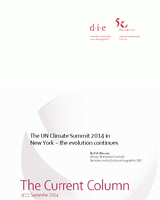The UN Climate Summit 2014 in New York - The evolution continues
Messner, DirkThe Current Column (2014)
Bonn: German Development Institute / Deutsches Institut für Entwicklungspolitik (DIE) (The Current Column of 25 September 2014)
Bonn, New York City, 25 September 2014. UN Secretary-General Ban Ki-moon invited political leaders from around the world to New York City for the Climate Summit 2014 on 23 September 2014. The goal was to generate political momentum in order to improve the chances of success for a world climate treaty next year in Paris under the aegis of the United Nations Frame-work Convention on Climate Change. Was the summit a success?
For a week, New York was the global capital of climate protection. Sunday saw 400,000 people demonstrate ahead of the Climate Summit 2014 – an impressive sign. Hundreds of events focusing on solving the climate crisis were held on the margins of the summit. Ban Ki-moon has succeeded in bringing climate policy back to the top of the global policy agenda and into the headlines of the world's press. No easy task in the time of crises and war in Iraq, Syria, Libya, Ukraine and Russia.
But has the summit raised hopes of a successful outcome to Paris 2015? Three viewpoints were articulated in New York. Ban Ki-moon's verdict at the end: “This was a great day!” 100 heads of state and government, over 800 leading experts from industry, science and academia and civil society had attended, the vast majority confirming the urgency of prompt action. In addition, the Secretary-General could point to numerous remarkable initiatives. In the New York Declaration on Forests governments, including those of Norway, Germany, Peru, Colombia, the Republic of the Congo and Uganda, as well as civil society organisations and forestry and bioenergy companies committed themselves to taking significant action to halt the destruction of the forests by 2030 and restore 350 million hectares of degraded land to an arable state. This would result in the agricultural potential to feed around 400 million people. The World Bank presented a network of over 1,000 companies dedicated to putting a price on greenhouse gas emissions. 25 corporate groups, including Unilever, Nestlé and Philips, announced especially ambitious initiatives. In future, they are to put a price on emissions within the respective firms in order to achieve a prompt fall in greenhouse emissions and render public account of the success of these measures. Initiatives presented in the realm of divestment are also interesting. Universities such as Harvard and Stanford, the Rockefeller Brothers Fund, the World Council of Churches, pension funds, the World Bank, the KfW development bank and individuals are beginning to divest from fossil energy companies and transform them into climate-friendly investments. This “global divest-invest coalition” is set to divert 200 billion US dollars to green investments by the end of 2015. The Secretary-General described these and other initiatives, such as the German energy transition or Energiewende, as an awakening point.
Jeffrey Sachs, influential economist and chair of the United Nations Sustainable Development Solutions Network (SDSN), remained sceptical. He pointed out that during the climate summit he had heard of no climate protection initiatives that could irreversibly trigger the shift to climate friendliness: “When will the radical reductions in emissions in the USA and China that are so urgently needed be introduced? When will the EU reform its emissions trading system? The fact is that emissions are still increasing.” This, too, is hard to dismiss out of hand.
A third perspective was also discussed at the summit. The climate summit was no “revolutionary moment”, no tipping point that would introduce the irreversible path to climate friendliness. A climate-neutral global economy is a project that will span a generation, but one that is at least gathering steam. Here is one optimistic interpretation of what we observe: at the UN Climate Summit in Copenhagen in 2009 everyone was hoping for a global treaty that would trigger climate-friendly change at local and national level. The opposite is now the case: an ever-increasing patchwork of low carbon dynamics is taking shape around the globe and with a little creativity it is possible to imagine what a global economy could look like in which this has been scaled up by a factor of ten by 2050. The fact that the global economy and key players in business, society and politics are changing course can only serve to increase the chances of a climate treaty.
It is hard to say where exactly climate protection stands after the summit. Perhaps it is important to mention what was NOT discussed in New York. In contrast to a few years ago, the voices of the climate change sceptics were of no significance; powerful corporate alliances promoting “business as usual” and a “high-carbon future” were not to be found in New York; the World Bank and OECD are now attempting to operationalise the concept of a “zero carbon economy”. The fossil economy still possesses major veto potential. However, the climate protection movement has claimed a stronger normative hold over the future of the global economy.
This Current Column is an English version of a preprint of a Comment that will be published in VEREINTE NATIONEN 5/2014.

